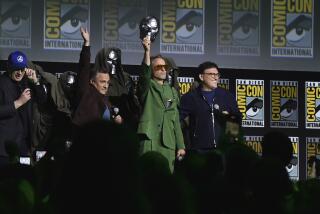Spider-Man’s Long-Lost Parent
When “Spider-Man” credits roll on Friday, a name will appear alongside Stan Lee’s that may elicit wild cheering from a few audience members and muted confusion from everyone else. The name is Steve Ditko. And the people applauding are comic-book fans thrilled that Ditko, the original artist and co-creator of Spider-Man, has been given proper credit--at long last--on the occasion of Spidey’s big-screen debut.
Ditko won’t be anywhere in the vicinity of the movie’s hype machine, though. While Lee, Spider-Man’s other, better known co-creator, is pumping the film at media events and premiere parties, Ditko will probably be at his cramped studio in midtown Manhattan, hunched over a drawing board working on more comics.
Then again, it’s hard to know exactly what Ditko will be doing. The first rule of Steve Ditko is you don’t talk about Steve Ditko. Not to the press, not even to friends or peers. Intensely private, Ditko is an enigmatic figure--the J.D. Salinger of comics. He avoids publicity and hasn’t given an interview in more than 35 years. Only a few published photographs of him are known to exist, and good luck finding them.
“He’s the exact opposite of me,” says Lee, who has spent the last 40 years as the public face of Spider-Man and the rest of Marvel Comics’ superhero pantheon.
Those who know Ditko say he prefers to let his work speak for itself. In a career spanning five decades, the 74-year-old artist has produced hundreds of comic books in genres ranging from horror to science fiction to erotica. But nothing in Ditko’s oeuvre has matched the popularity and success of his work on Spider-Man, which he and Lee unleashed on the world in the early 1960s in “Amazing Fantasy” No. 15 and the first 38 issues of “Amazing Spider-Man.”
With few exceptions, no comic-book series has been the source of as much controversy among fans and historians. The debates include such esoteric questions as who dreamed up Spider-Man’s webbing or his belt-mounted flashlight. Then there’s the intriguing mystery of why Ditko suddenly departed the title in 1966 and never drew a Spider-Man story again.
On their pioneering Spider-Man run, Lee and Ditko tweaked the traditions of superhero-dom. Eschewing the tedious infallibility of Superman, they saddled the webslinger with real-life dilemmas--money troubles, a sick Aunt May--and somewhat bizarre superpowers. Lee enlivened the action with snappy, humorous dialogue; Ditko’s moody and naturalistic line work brought Spider-Man down to earth, emphasizing his humanity. In those formative years, the co-creators established the mythology that has guided Spider-Man’s development ever since. The Green Goblin, played by Willem Dafoe in the movie, is a Ditko-Lee creation.
Ditko’s ink prints are especially visible in the film. “You can see a lot of Ditko’s influence in the way Spidey moves on the big screen--the classic poses and movements are all up there,” says “Spider-Man” producer Laura Ziskin.
The film credit reads, “Based on the Marvel Comic Book by Stan Lee and Steve Ditko.” That may not seem very significant, but to Ditko fans it represents a long-awaited validation. In one of those injustices for which the comics industry is famous, Ditko has not received any royalties from the billion-dollar franchise based on Spider-Man because he co-created the character on a work-for-hire basis.
More important to his fans, there has long been a public misconception that Stan Lee was the sole creator of Spider-Man--fostered by a combination of Lee’s grandstanding, Ditko’s reclusiveness and Marvel’s practice of not giving credit to the original creators of its heroes. In the March issue of the long-running “Amazing Spider-Man,” Marvel listed Ditko’s name on the title page for the first time since 1966. Series editor Axel Alonso says the credit was a “tip of the hat to Ditko” that may appear again around the time of the movie, but not as a matter of company policy.
Personal Details About Ditko Are Scarce
The personal details that are known about Steve Ditko would fit on one side of an index card. He was born Nov. 2, 1927, in Johnstown, Pa., the son of Eastern European immigrants. As a child, he was a fan of Batman and the Spirit. He has a brother named Patrick. In 1945, he graduated from Greater Johnstown High School. Five years later, he set off for New York and enrolled in the Cartoonists and Illustrators School, where he studied under Golden Age Batman artist Jerry Robinson. He is a lifelong bachelor, and he has no children.
Gary Groth is editor in chief of the Comics Journal, an industry publication noteworthy for its expansive, in-depth interviews. He has known Ditko for more than 20 years and has been trying to land an interview for at least as long. “I don’t think we’re going to get one,” Groth says.
According to friends and former collaborators, Ditko’s life has been heavily influenced by Objectivism, the philosophy of rational thought and individual free will sketched out in Ayn Rand’s novels “The Fountainhead” and “Atlas Shrugged.” Ditko sees the world in stark black and white, with no gray in between. As such, he does not compromise on issues that contradict his artistic or ethical sensibilities.
Marv Wolfman, a comics writer and the creator of Blade, worked with Ditko on the Marvel comic “Machine Man” in the late 1970s. Wolfman remembers that Ditko was more than willing to discuss Spider-Man and his supporting cast, but that the artist nixed any attempts to incorporate the wallcrawler into the new series. “He always felt that Spidey should never be older than 16, because that was the last year a kid could totally screw up,” Wolfman says.
Affront to Artistic Principles Prompts Anger
Subsequent efforts by Marvel editors and writers, including Lee, to bring Ditko back to the Spider-Man fold were similarly rebuffed. “He never wanted to do Spider-Man again,” says Jack C. Harris, who edited Ditko at DC Comics.
Ditko’s acquaintances describe him as polite, friendly and soft-spoken. But Ditko also has a dark side, which emerges most acutely when his principles are affronted. In one incident, he stopped doing a series and furiously chastised the publisher because of a slight color error on the cover of the first issue.
Author Cat Yronwode, a former comics publisher, endured Ditko’s wrath when she tried to write a book about him in the mid-1980s. When Ditko found out that Yronwode had interviewed his brother, he exploded. “He felt that I had invaded his privacy.”
Soon after, Yronwode’s manuscript for “The Art of Steve Ditko” and all her notes were destroyed in a house flood. “That was the end of it,” she says. “I felt that for whatever reason, maybe it was God speaking, I was not meant to do this.”
True to form, Ditko declined to be interviewed for this article, as did his brother.
Ditko’s first published work, “Black Magic” No. 27, appeared in 1953. During the late ‘50s, he worked with Lee at Atlas, the predecessor to Marvel Comics, on short horror and fantasy stories with titles like “Zzutak: The Thing That Shouldn’t Exist” and “Fear in the Night.” “He helped me out so many times when we had an emergency and I needed an artist to do something quickly,” Lee recalls. “He was a joy and a pleasure to work with.”
Lee and Ditko’s first Spider-Man story was actually an experiment. In the early 1960s, Marvel had pulled out of a decade-long slump and was flush with the success of its 1961 title “The Fantastic Four.” Editor Lee wanted to follow up with more heroes, beginning with a nerdy high school student who gains the proportionate strength of a spider in a freak lab accident. Lee’s publisher, Martin Goodman, hated the idea, particularly the insect theme and the fact that the hero was a teenager. Lee compromised by slotting Spider-Man’s inaugural tale into the final issue of a canceled fantasy series.
Spider-Man Co-Creators Begin to Disagree
Initially, Lee assigned the art chores to legendary comics artist Jack Kirby, with whom he had co-created the Fantastic Four. Kirby returned with several pages of bombastic heroic renderings Lee didn’t think were quite right, so he turned to Ditko. “There was something about the way he drew,” Lee says. “It had a realistic style, it wasn’t too exaggerated or too over the top.”
“Amazing Fantasy” No. 15 hit newsstands in August 1962. When the issue’s staggering sales figures came back a few months later, Lee gave the character his own series. “Amazing Spider-Man” debuted in March 1963, and almost immediately became a hit.
Behind the scenes, though, the co-creators began to disagree on the title’s direction. After a few dozen issues, Ditko was plotting the book himself and turning the penciled pages over to Lee, who filled in the dialogue. “I didn’t know what he’d be bringing me. It was almost like doing a crossword puzzle,” Lee says.
By the time Roy Thomas joined the company as assistant editor in 1965, Ditko and Lee were no longer speaking to each other, using intermediaries to communicate. “There wasn’t a lot of anger, it was just that they got to arguing so much over the plot lines,” Thomas recalls. Then, one day in early 1966, Ditko walked into Marvel’s offices on Madison Avenue, delivered a stack of pages, and quit. The only person who knows for sure why Ditko left is Ditko.
The lore repeated in comic book circles is that the final straw was a dispute over the unmasking of the Green Goblin. Ditko wanted him to turn out to be someone who hadn’t been seen before; Lee argued that he should be an established character so readers wouldn’t feel cheated.
Lee says he remembers the disagreement over the Green Goblin but doesn’t think that’s what prompted Ditko’s resignation. “I really don’t know why he left to this day, and he’s never told me,” Lee says.
For many years, Ditko remained silent. Recently, however, he began writing a series of essays in the Comics, a small-circulation newsletter about the history of comic books. The reason he broke his silence, Ditko writes, was due to a few public incidents, including a 1998 Time magazine article that credited Lee as the “creator” of Spider-Man.
Much of his writing is given over to odd Ayn Randian ramblings like the following: “Too many people choose to be unjust takers in their dealing, transactions with others. They want, demand, the unearned and undeserved.”
But on the matter of why he gave up the series, he writes only, “I know why I left Marvel but no one else in this universe knew or knows why. It may be of a mild interest to realize that Stan Lee chose not to know, to hear why, I left.” Lee is aware of Ditko’s resentment. A few years ago, Lee tried to set the record straight by sending Ditko a letter in which he said, “I have always considered Steve Ditko to be Spider-Man’s co-creator.” Ditko’s response appeared in the May 2001 issue of the Comics: “‘Considered’ means to ponder, look at closely, examine, etc. and does not admit, or claim, or state that Steve Ditko is Spider-Man’s co-creator.”
“At this point, I don’t know what to say,” Lee says.
“I don’t want this to turn into a feud, because I love the guy. But I don’t know what to do to make him happy.”
More to Read
The biggest entertainment stories
Get our big stories about Hollywood, film, television, music, arts, culture and more right in your inbox as soon as they publish.
You may occasionally receive promotional content from the Los Angeles Times.










